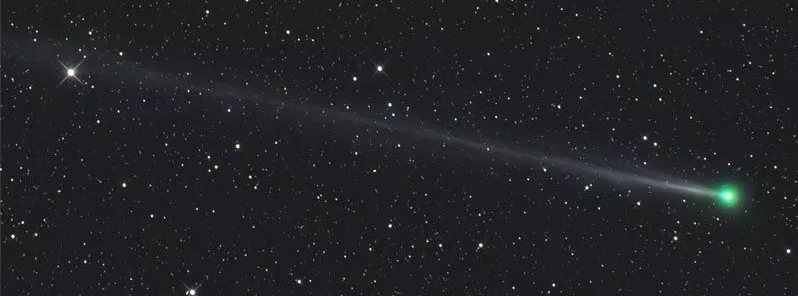View Other Topics.
 Feb 11, 2017
Feb 11, 2017
WatchersNews.com tells us that a green-hued comet will also hurl past Earth in the early morning hours of 11 February 2017. According to Sky & Telescope the comet, 45P/Honda-Mrkos-Pajdusakova, will zoom by the planet at 3 a.m. EST at a distance of 7.7 million miles:
While it won't be coming in for a landing, 45P/H-M-P will miss the planet by just 7.7 million miles or about 32 times the Earth-Moon distance. Because of its proximity, we'll see this frenetic fuzz ball barrel across more than 2 hours of R.A. and nearly 20° of declination in the next five days.
After more than 5 years, Comet 45P/Honda-Mrkos-Pajdusakova, also known as the Green Comet, will make another close approach to Earth. It can be seen using small telescopes, but 45P has lost its tail after it passed the perihelion (closest approach to the Sun). Currently, it is 3 times dimmer than expected and it's unlikely it will reach naked-eye visibility.
At the time of its closest approach, around 08:20 UTC (3:00 PM EST) on February 11, 2017, Comet 45P will flyby Earth at a safe distance of 32.4 LD (12.4 million km / 7.7 million miles) at a speed (relative to the Earth) of 22.91 km/s.
45P is a Jupiter-family comet with an estimated diameter of 1.6 km (0.99 miles). Its green color comes from diatomic carbon (C2) emitted from its nucleus.
According to the Minor Planet Center, this is the 8th closest pass of any comet in the modern era (since ~1950, when modern technology started being used to study comets). Interestingly, 45P made an even closer approach on its previous orbit (23 LD), so it is also on the list as the 5th closest, Dr. Tony Phillips of the SpaceWeather.com reports.
Analyzing new photos submitted to his website on February 7, it became apparent that the comet has lost its tail. Phillips said that solar heating, as the comet passed perihelion, might have vaporized so much material from the comet's icy core that there is insufficient left for a flamboyant tail. For the same reason, the comet may be dimmer than expected.
Amateur astronomers with small telescopes can still see it, but it seems unlikely 45P will become a naked eye comet.
It is currently visible in the morning sky in the constellation Hercules. It will then pass through constellations Corona Borealis, Bootes, Canes Venatici, Ursa Major and onto Leo by the end of February.
The next time this comet comes close to Earth will be in 2022.
Tags:
#comet#45P,#comet,#minor#planet#center,#astromers#starzpsychics.com,#starz#advisors
Comet 45P Arriving Today .

WatchersNews.com tells us that a green-hued comet will also hurl past Earth in the early morning hours of 11 February 2017. According to Sky & Telescope the comet, 45P/Honda-Mrkos-Pajdusakova, will zoom by the planet at 3 a.m. EST at a distance of 7.7 million miles:
While it won't be coming in for a landing, 45P/H-M-P will miss the planet by just 7.7 million miles or about 32 times the Earth-Moon distance. Because of its proximity, we'll see this frenetic fuzz ball barrel across more than 2 hours of R.A. and nearly 20° of declination in the next five days.
After more than 5 years, Comet 45P/Honda-Mrkos-Pajdusakova, also known as the Green Comet, will make another close approach to Earth. It can be seen using small telescopes, but 45P has lost its tail after it passed the perihelion (closest approach to the Sun). Currently, it is 3 times dimmer than expected and it's unlikely it will reach naked-eye visibility.
At the time of its closest approach, around 08:20 UTC (3:00 PM EST) on February 11, 2017, Comet 45P will flyby Earth at a safe distance of 32.4 LD (12.4 million km / 7.7 million miles) at a speed (relative to the Earth) of 22.91 km/s.
45P is a Jupiter-family comet with an estimated diameter of 1.6 km (0.99 miles). Its green color comes from diatomic carbon (C2) emitted from its nucleus.
According to the Minor Planet Center, this is the 8th closest pass of any comet in the modern era (since ~1950, when modern technology started being used to study comets). Interestingly, 45P made an even closer approach on its previous orbit (23 LD), so it is also on the list as the 5th closest, Dr. Tony Phillips of the SpaceWeather.com reports.
Analyzing new photos submitted to his website on February 7, it became apparent that the comet has lost its tail. Phillips said that solar heating, as the comet passed perihelion, might have vaporized so much material from the comet's icy core that there is insufficient left for a flamboyant tail. For the same reason, the comet may be dimmer than expected.
Amateur astronomers with small telescopes can still see it, but it seems unlikely 45P will become a naked eye comet.
It is currently visible in the morning sky in the constellation Hercules. It will then pass through constellations Corona Borealis, Bootes, Canes Venatici, Ursa Major and onto Leo by the end of February.
The next time this comet comes close to Earth will be in 2022.
Share this article with friends!
Tags:
#comet#45P,#comet,#minor#planet#center,#astromers#starzpsychics.com,#starz#advisors






